Related Research Articles
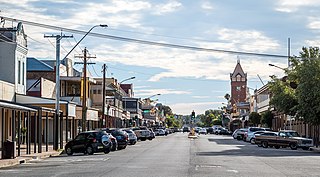
Broken Hill is a city in the far west region of outback New South Wales, Australia. An inland mining city, it is near the border with South Australia on the crossing of the Barrier Highway (A32) and the Silver City Highway (B79), in the Barrier Range. It is 315 m (1,033 ft) above sea level, with a cold semi-arid climate, and an average rainfall of 265 mm (10.4 in). The closest major city is Mildura, 300 km (190 mi) to the south and the nearest State Capital City is Adelaide, the capital of South Australia, which is more than 500 km (310 mi) to the southwest and linked via route A32, the Barrier Highway.

The National Gallery of Australia (NGA), formerly the Australian National Gallery, is the national art museum of Australia as well as one of the largest art museums in Australia, holding more than 166,000 works of art. Located in Canberra in the Australian Capital Territory, it was established in 1967 by the Australian Government as a national public art museum. As of 2022 it is under the directorship of Nick Mitzevich.
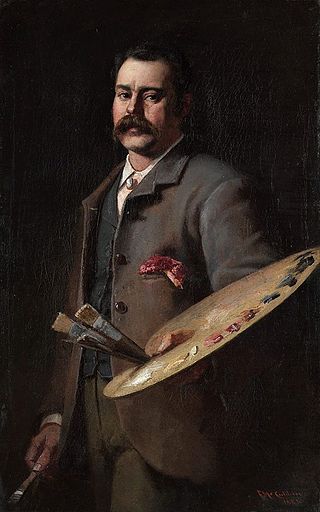
Frederick McCubbin was an Australian artist, art teacher and prominent member of the Heidelberg School art movement, also known as Australian impressionism.
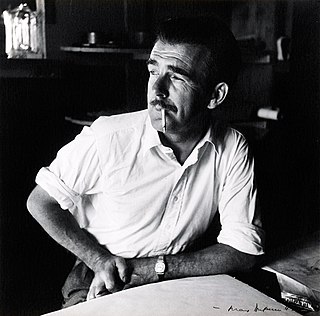
Sir William Dobell was an Australian portrait and landscape artist of the 20th century. Dobell won the Archibald Prize, Australia's premier award for portrait artists on three occasions. The Dobell Prize is named in his honour.
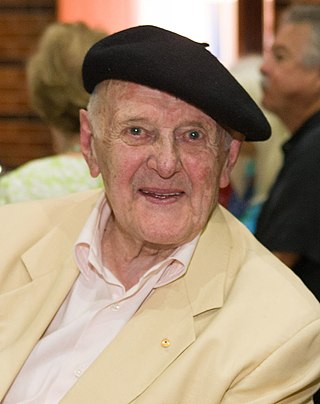
John Henry Olsen AO OBE was an Australian artist and winner of the 2005 Archibald Prize. Olsen's primary subject of work was landscape.

Albert Lee Tucker was an Australian artist and member of the Heide Circle, a group of modernist artists and writers associated with Heide, the Melbourne home of art patrons John and Sunday Reed. Along with Heide Circle members such as Sidney Nolan and Arthur Boyd, Tucker became associated with the Angry Penguins art movement, named after a publication founded by poet Max Harris and published by the Reeds.

Kevin Charles "Pro" Hart, MBE, was an Australian artist, born in Broken Hill, New South Wales, who was considered the father of the Australian Outback painting movement and his works are widely admired for capturing the true spirit of the outback. He grew up on his family's sheep farm in Menindee and was nicknamed "Professor" during his younger days, when he was known as an inventor.
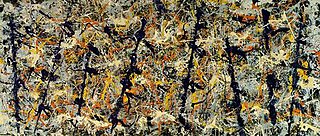
Blue Poles, also known as Number 11, 1952 is an abstract expressionist painting by American artist Jackson Pollock. It was purchased amid controversy by the National Gallery of Australia in 1973 and today remains one of the gallery's major paintings.
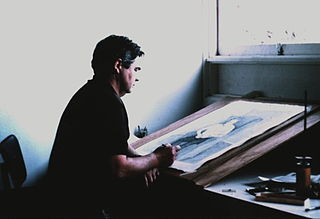
John Brack was an Australian painter, and a member of the Antipodeans group. According to one critic, Brack's early works captured the idiosyncrasies of their time "more powerfully and succinctly than any Australian artist before or since. Brack forged the iconography of a decade on canvas as sharply as Barry Humphries did on stage."
Richard Larter was an Australian painter, often identified as one of Australia's few highly recognisable pop artists. Larter also frequently painted in a Pointillist style. He took advantage of unusual techniques with painting: using a syringe filled with paint to create his early works, and juxtaposing multiple images on to a canvas. Many of his works are brightly coloured and draw on popular culture for source materials, reproducing news photographs, film stills, and images from pornography. He was married to Pat Larter, an artist who was involved in the Mail art movement, then performance art and finally painting in a brightly coloured style similar to Richard's. The Larters emigrated to Australia in 1962. Richard Larter's pop art was less ironic than his American and English counterparts. In this Larter is similar to other noted Australian pop artists, such as, Mike Brown and Martin Sharp.

John Henry Absalom was an Australian artist, author and adventurer.

Jack Hamilton Bush was a Canadian abstract painter. A member of Painters Eleven, his paintings are associated with the Color Field movement and Post-painterly Abstraction. Inspired by Henri Matisse and American abstract expressionist painters such as Helen Frankenthaler and Morris Louis, Bush encapsulated joyful yet emotional feelings in his vibrant paintings, comparing them to jazz music. Clement Greenberg described him as a "supreme colorist", along with Kenneth Noland in 1984. Bush explained that capturing the feeling of a subject rather than its likeness was
a hard step for the art loving public to take, not to have the red look like a side of a barn but to let it be the red for its own sake and how it exists in the environment of that canvas.
Kumantje Jagamara, also known as Kumantje Nelson Jagamara, Michael Minjina Nelson Tjakamarra, Michael Nelson Tjakamarra and variations, was an Aboriginal Australian painter. He was one of the most significant proponents of the Western Desert art movement, an early style of contemporary Indigenous Australian art.
Susan Dorothea White is an Australian artist and author. She is a narrative artist and her work concerns the natural world and human situation, increasingly incorporating satire and irony to convey her concern for human rights and equality. She is the author of Draw Like da Vinci (2006).
Robin Sellick is an Australian portrait photographer, widely regarded as "Australia's leading celebrity photographer".
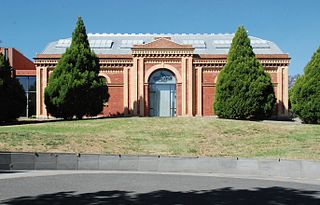
Bendigo Art Gallery is an Australian art gallery located in Bendigo, Victoria. It is one of the oldest and largest regional art galleries.

Florence May Harding, known as May Harding, was a teacher, naturalist, botanist, and artist at Broken Hill, New South Wales.

Lina Bryans, was an Australian modernist painter.
Dorothy Mary Braund (1926–2013) was an Australian post-war figuration and contemporary feminist artist, whose practice included painting, printmaking and teaching. Braund's extensive career was instrumental in contributing to the Modernist art scene, along with a generation of significant women artists including: Mary Macqueen, Barbara Brash, Anne Marie Graham, Constance Stokes, Anne Montgomery (artist) and Nancy Grant. Braund's first solo exhibition, held in 1952 at Peter Bray Gallery in Melbourne, launched her career and from then on she had consistent shows and exhibitions. Braund has had approximately 29 solo exhibitions and participated in 25 group exhibitions throughout her career. Braund is also a part of the Cruthers Collection of Women's Art.

Samuel Byrne was an Australian naïve painter and folk historian who visually chronicled the rise of Broken Hill, from its frontier days right through to the establishment of a modern city. Without any formal training, Byrne took to painting when he was in his seventies after retiring from a lifetime working on Broken Hill's mines. His painstakingly detailed panoramas of Broken Hill's township were discovered by Leonard French, who brought him to the attention of Sydney and Melbourne's art connoisseurs. Byrne is best known for painting his memories of subjects that held a personal fascination for him; Broken Hill's rabbit plagues, Sturt's desert peas, dust storms, industrial riots, and pioneering mining scenes. As a trade unionist and having first hand experience of the harsh mine conditions, his works are often imbued with a working-class consciousness and show a deep sensitivity to the plight of the victimised. Although the media often compared him to Grandma Moses, as James Gleeson writes, Byrne "paints in a manner that is so consistent that we are obliged to acknowledge it as a personal style."
References
- 1 2 Walker, Anna (6 June 2006). "Brushmen's impact grows as ranks thin". The World Today. Australian Broadcasting Corporation. Retrieved 28 March 2007.[ dead link ]
- 1 2 Broken Hill Brushmen Exhibition [ permanent dead link ], Australian Broadcasting Corporation, 29 May 2006
- ↑ "Pro Hart: hang the lot of them", The Sydney Morning Herald, 1 April 2006
- ↑ "Bushman, painter and author Jack Absalom dies at 91". ABC News. 23 March 2019. Retrieved 2 February 2023.
- ↑ "ABC broadcaster John Pickup, the last of the Brushmen of the Bush, dies aged 91". ABC News. 1 February 2023. Retrieved 2 February 2023.